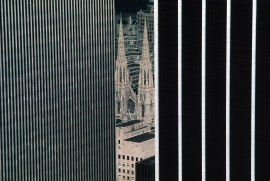Ellen Bornkessel, Peikwen Cheng, Susan Dobson,
Elliott Erwitt, Thomas Hoepker
06.03. - 07.04.2017
Vernissage on Saturday, 4th of March 2017 from 7 pm – 9.30 pm
Opening hours:
Thursday – Friday 4 pm – 7 pm, Saturday 11 am – 6 pm
The "altered landscape" has long been a theme in photography. In 1975 William Jenkins curated the exhibition New Topographics at George Eastman House, which featured Robert Adams and Stephen Shore, among others. This seminal exhibition was both a reflection of the local environment, including a highly conceptual, documentary, detached and socially critical comment on an increasingly modern world, which was driven by economic rationality and mostly absent of its makers.
The exhibition City Landscapes (Stadt-Landschaften) at in focus Gallery certainly associates itself with the movement, however, it delves further. Whilst the New Topographics photographers primarily emphasised an objective, documentary focus, the artists in this exhibition are specifically interested in interpreting and examining the relationship between the human being and altered urban landscapes.
Elliott Erwitt’s photographs of adolescents sunbathing on cars and Thomas Hoepker’s rooftop image of a woman sunbaking amidst an urban jungle depict – with a touch of irony – how, even in dismal, constructed or rundown urban landscapes, human beings arrange themselves and yet still dream of more beautiful surroundings or of summer and holidays.
Ellen Bornkessel’s photographs from the series, Play portray people who have adopted the city as their natural environment. They conquer the urban surroundings of cities and make them their own through their nighttime antics. In the series Ghost Mountains, the nightscape is hidden in valleys or behind mountains and illuminated solely by the city’s artificial light.
The landscape is ever changing: whether over the seasons or due to the development of cities. Transformations such as these are documented and deliberated upon by Peikwen Cheng and largely through his nighttime scenes.
Susan Dobson also illustrates nighttime landscapes in her series Moonrise, which due to the moonlight at first appear romantic and upon closer inspection of the uniform townhouse settlements, industrial estates or burning barns, become paradoxical. Another of Dobson’s series’, Retail, in which she employed image manipulation, reveals the interchangeable and bleak make-up of the majority of suburban supermarkets.


